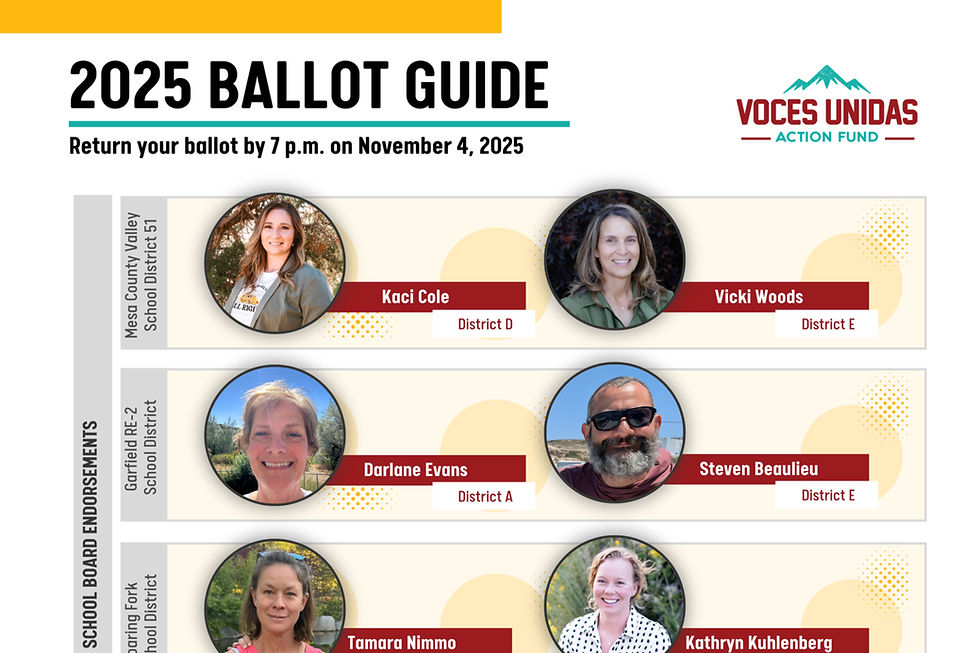Western Slope school districts struggle with low proficiency and deep achievement gaps
- Voces Unidas de las Montañas

- Sep 10
- 3 min read
The 2025 Colorado Measures of Academic Success (CMAS) results show low proficiency rates and large achievement gaps for Latino students across the Western Slope. In many districts, Latino students score far below their White peers. In others, both groups perform at low levels.
Summit RE-1 reports one of the largest gaps in the state. Only 16% of Latino students reached proficiency in English Language Arts (ELA), compared to 61% of White students. In math, 13% of Latino students were proficient compared to 53% of White students. In science, 15% of Latino students were proficient compared to 55% of White students.
Steamboat Springs RE-2 shows similar patterns. In ELA, 38% of Latino students were proficient compared to 74% of White students. In math, 20% of Latino students were proficient compared to 65% of White students. In science, 21% of Latino students were proficient compared to 66% of White students.
In Roaring Fork RE-1, 19% of Latino students reached proficiency in ELA compared to 60% of White students. In math, 12% of Latino students were proficient compared to 49% of White students. In science, 18% of Latino students were proficient compared to 55% of White students.
Eagle County shows similar disparities. In ELA, 24% of Latino students were proficient compared to 62% of White students. In math, 14% of Latino students were proficient compared to 49% of White students. In science, 19% of Latino students were proficient compared to 55% of White students.
Rural districts also report low proficiency overall. In Garfield 16, just 8% of Latino students and 19% of White students scored proficient in ELA. Garfield RE-2 reports Latino proficiency at 21% and White proficiency at 45% in ELA. In Mesa 51, Latino proficiency in ELA was 29% compared to 49% for White students, and in math, Latino proficiency was 22% compared to 40% for White students. Montrose RE-1J shows Latino proficiency at 22% and White proficiency at 49% in ELA, and Latino proficiency at 10% and White proficiency at 34% in math. Delta 50(J) reports Latino proficiency at 30% and White proficiency at 51% in ELA, and Latino proficiency at 19% and White proficiency at 34% in math.
Latino families are most affected in districts like Roaring Fork and Eagle, where Latinos make up more than half of enrollment. Polling from the Colorado Latino Policy Agenda shows education is a top priority, with closing achievement gaps seen as essential. Yet, test results show gaps remain wide and progress is slow.
The data highlight the need for action by school boards and state leaders. Districts with large gaps need to double down to accelerate learning, so that students can make up the equivalent of two to three grade levels in a single year. Others with low performance across groups need stronger system-wide investment.
Western Slope Districts with the Largest Achievement Gaps (Ranked by ELA):
District | ELA Latino % | ELA White % | ELA Gap | Math Latino % | Math White % | Math Gap | Science Latino % | Science White % | Science Gap |
Summit RE-1 | 16% | 61% | 45 pts | 13% | 53% | 40 pts | 15% | 55% | 40 pts |
Roaring Fork RE-1 | 19% | 60% | 42 pts | 12% | 49% | 37 pts | 18% | 55% | 37 pts |
Eagle County RE 50 | 24% | 62% | 38 pts | 14% | 49% | 35 pts | 19% | 55% | 36 pts |
Telluride R-1 | 35% | 74% | 39 pts | 21% | 54% | 33 pts | 22% | 55% | 33 pts |
Steamboat Springs RE-2 | 38% | 74% | 36 pts | 20% | 65% | 45 pts | 21% | 66% | 45 pts |
Aspen 1 | 34% | 63% | 29 pts | 15% | 53% | 38 pts | 18% | 56% | 38 pts |
Mesa County Valley 51 | 29% | 49% | 20 pts | 22% | 40% | 18 pts | 21% | 39% | 18 pts |
Montrose County RE-1J | 22% | 49% | 27 pts | 10% | 34% | 23 pts | 20% | 42% | 22 pts |
Delta County 50(J) | 30% | 51% | 19% | 34% | 15 pts | 21% | 37% | 16 pts | |
Garfield RE-2 | 21% | 45% | 24 pts | — | — | — | — | — | — |
Garfield 16 | 8% | 19% | 11 pts | — | 9% | — | — | — | — |
Note: Math and Science results for Garfield RE-2 and Garfield 16 were not available or suppressed due to small subgroup sizes.






